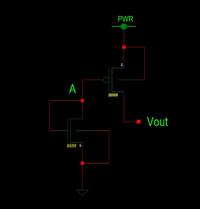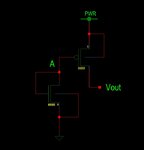desperatejobseeker
Newbie level 5
- Joined
- Mar 21, 2012
- Messages
- 10
- Helped
- 1
- Reputation
- 2
- Reaction score
- 1
- Trophy points
- 1,283
- Location
- shanghai, china
- Activity points
- 1,369
Hi all,
An NMOS is dioded-connected, that has its Gate/Drain tied to another PMOS gate and both its body and souce are tied to gnd. I saw many schematics using this kind of structure, I wonder how it could work? Although for the NMOS Vds>Vgs-Vth, from my perspective, there is no voltage bias at Gate/Drain, cuz they r only tied together to the gate of another PMOS. How could it possible work?
Thanks in advance!
An NMOS is dioded-connected, that has its Gate/Drain tied to another PMOS gate and both its body and souce are tied to gnd. I saw many schematics using this kind of structure, I wonder how it could work? Although for the NMOS Vds>Vgs-Vth, from my perspective, there is no voltage bias at Gate/Drain, cuz they r only tied together to the gate of another PMOS. How could it possible work?
Thanks in advance!

